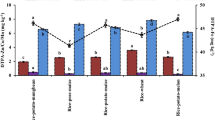Abstract
Excessive soil copper (Cu) availability leads to plant growth retardation and leaf chlorosis, and the contamination of Cu in the food chain would be detrimental to human and animal health. The most important path for Cu accumulation in plants is uptake from soils. It is therefore important to understand the availability of soil Cu and its controlling factors to modify Cu availability and prevent excessive Cu from entering the food chain. The present study proposed a general regression neural network (GRNN) to simulate the availability index of soil Cu (available heavy mental concentrations/total heavy metal concentrations), based on the influencing factors of total Cu concentration, pH, organic matter (OM), available phosphorus (AP), and readily available potassium (RAK). Results showed that total Cu concentration, combined with OM and AP, achieved the lowest RMSE value (0.0524) for the modeled value of the availability index of soil Cu. The simulated results by GRNN and the ground truth values had better agreement (R 2 = 0.7760) than that by a linear model (R 2 = 0.6464) for 23 test samples. Moreover, GRNN obtained lower averaged relative errors than linear model. This demonstrated that GRNN could be used to simulate the availability index of soil heavy metals and gained better results than linear model.



Similar content being viewed by others
References
Agricultural Chemistry Committee of China (1983) Conventional methods of soil and agricultural chemistry analysis. Science Press, Beijing (in Chinese)
Alloway BJ (1995) Heavy metals in soils. Blackie Academic and Professional, London
Brun LA, Maillet J, Richarte J, Herrmann P, Pemy JC (1998) Relationships between extractable copper, soil properties and copper uptake by wild plants in vineyard soils. Environ Pollut 102:151–161
Demirevska-kepova K, Simova-Stoilova L, Stoyanova Z, Hŏlzer R, Feller U (2004) Biochemical changes in barley plants after excessive supply of copper and manganese. Environ Exp Bot 52:253–266
Elsharkawy AM, Foda SG (1998) EOS simulation and GRNN modeling of the constant volume depletion behavior of gas condensate reservoirs. Energy Fuels 12(2):353–364
Erkmen B, Yildirim Y (2008) Improving classification performance of sonar targets by applying general regression neural network with PCA. Expert Syst Appl 35:472–475
Fishetti AI, Andrade A (2002) Porosity images from well logs. J Pet Sci Eng 36:149–158
Holmgren GGS, Meyer MW, Chaney RL, Daniels RB (1993) Cadmium, lead, zinc, copper, and nickel in agricultural soils of United States of America. J Environ Qual 22:335–348
Jervase AJ, Lawati AA, Dorvlo AS (2003) Contour maps for sunshine ratio for Oman using radial basis function generated data. Renew Energy 28:487–497
Jisu B, Hesternberg D (2004) Dissolution of trace element contaminants from two coastal plain soils as affected by pH. J Environ Qual 33:891–901
Lawati AA, Dorvlo AS, Jervase AJ (2003) Monthly average daily solar radiation and clearness index contour maps over Oman. Energy Convers Manag 44:691–705
Lewis S, Donkin ME, Depledge MH (2001) Hsp70 expression in Enteromorpha intestinalis (Chlorophyta) exposed to environmental stressors. Aquat Toxicol 51:277–291
Lin FF (2006) Study on the transfer characteristics of copper from soils to major vegetables in Fujian Province. Ph.D. Thesis, Fujian Agriculture and Forestry University, Fujian (in Chinese)
Martínez CE, Motto HL (2000) Solubility of lead, zinc and copper added to mineral soils. Environ Pollut 107:153–158
McGrath SP, Zhao FJ, Dunham SL, Crosland AR, Coleman K (2000) Long-term changes in the extractability and bioavailability of zinc and cadmium after sludge application. J Environ Qual 29:875–883
Ning WZ, Sun Q, Long XX (2000) Copper situation of vegetable garden soils and its relation to soil organic carbon. Guangdong Weiliang Yuansu Kexue 7(3):53–57 (in Chinese)
Obrador A, Alvarez JM, Lopez-Valdivia LM, Gonzalez D, Novillo J, Rico MI (2007) Relationships of soil properties with Mn and Zn distribution in acidic soils and their uptake by a barley crop. Geoderma 137:432–443
Shen ZQ, Zhou B, Kong FS, Bailey JS (2004) Study on spatial variety of soil properties by means of generalized regression neural network. Acta Pedol Sin 41(3):471–475
Soil Science Society of China (1999) Analysis methods for soil and agricultural chemistry. China Science and Technology Publishing House, Beijing
Specht DF (1991) A general regression neural network. IEEE Neural Netw 6:568–576
Wang G, Su MY, Chen YH, Lin FF, Luo D, Gao SF (2006) Transfer characteristics of cadmium and lead from soil to the edible parts of six vegetable species in southeastern China. Environ Pollut 144:127–135
Wu C, Luo Y, Zhang L (2010) Variability of copper availability in paddy fields in relation to selected soil properties in southeast China. Geoderma 156:200–206
Yi GH, Peng PH (2008) Correlations analysis between available main elements and total elements in Three-Gorges Reservoir Area. Guangdong Weiliang Yuansu Kexue 15(1):24–29
Zhang XY, Lin FF, Jiang YG, Wang K, Feng XL (2009) Variability of total and available copper concentrations in relation to land use and soil properties in Yangtse River Delta of China. Environ Monit Assess 155:205–213
Zhejiang Soil Survey Office (1994) Zhejiang soils. Zhejiang Technology Press, Hangzhou (in Chinese)
Zu YQ, Li Y, Chen HY, Chen JJ, Guhur M, Schvartz C (2003) Research on factors influencing concentrations of Pb, Cd, Cu and Zn in vegetables. J Agro-Environ Sci 22(3):289–292 (in Chinese)
Acknowledgment
The authors acknowledge the State Key Fundamental Science Funds of China (2010CB951504), the Public Benefit Research Foundation from National Land and Resource Administration Bureau (200811033), and National Technology Support Foundation (2006BAD10A07) for funding the research.
Author information
Authors and Affiliations
Corresponding author
Rights and permissions
About this article
Cite this article
Xiuying, Z., Zaiying, L., Zhong, T. et al. Simulation of the availability index of soil copper content using general regression neural network. Environ Earth Sci 64, 1697–1702 (2011). https://doi.org/10.1007/s12665-011-0973-4
Received:
Accepted:
Published:
Issue Date:
DOI: https://doi.org/10.1007/s12665-011-0973-4




